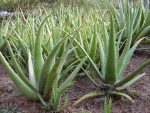 Best known as aloe vera, this evergreen succulent perennial is a member of Asphodelaceae family that also includes daylily (Hemerocallis), red hot poker (Kniphofia), and foxtail lily (Eremurus) Its origin is uncertain and it may be native to the Canary Islands, Madeira, and the Cape Verde Islands or the Arabian Peninsula. Plants grow 2-3′ high and form a stemless rosette of glaucous gray green, lanceolate leaves that are 1-2′ long and have white to reddish teeth. The yellow to orange-red flowers are 1-2″ long and appear in clusters on slender branched stems 2-3′ long from late spring to early summer. The leaves contain a mucilaginous sap that can be used to treat burns including sunburn and is often included in body lotions and creams for its restorative and medicinal properties. Plants are salt and drought tolerant and are useful in borders, succulent gardens, rock gardens, coastal gardens, herb gardens and containers. The genus name, Aloe, is derived from the Arabic word alloeh meaning bitter and shiny substance and refers to the latex in the leaves . The specific epithet, vera, is the Latin word meaning true, because it is the standard source for aloe vera, the pharmaceutical substance.
Best known as aloe vera, this evergreen succulent perennial is a member of Asphodelaceae family that also includes daylily (Hemerocallis), red hot poker (Kniphofia), and foxtail lily (Eremurus) Its origin is uncertain and it may be native to the Canary Islands, Madeira, and the Cape Verde Islands or the Arabian Peninsula. Plants grow 2-3′ high and form a stemless rosette of glaucous gray green, lanceolate leaves that are 1-2′ long and have white to reddish teeth. The yellow to orange-red flowers are 1-2″ long and appear in clusters on slender branched stems 2-3′ long from late spring to early summer. The leaves contain a mucilaginous sap that can be used to treat burns including sunburn and is often included in body lotions and creams for its restorative and medicinal properties. Plants are salt and drought tolerant and are useful in borders, succulent gardens, rock gardens, coastal gardens, herb gardens and containers. The genus name, Aloe, is derived from the Arabic word alloeh meaning bitter and shiny substance and refers to the latex in the leaves . The specific epithet, vera, is the Latin word meaning true, because it is the standard source for aloe vera, the pharmaceutical substance.
Type: Evergreen succulent perennial
Bloom: Spike-like clusters of tubular, yellow to orange-red, 1-2” long flowers from late spring to early summer
Foliage: Pale to gray-green, narrow, fleshy leaves containing mucilaginous sap.
Size: 8-36” H x 12-36” W (potted plants will be on the low end).
Light: Sun to light shade.
Soil: Average, medium moist, very well-drained; prefers a sandy soil.
Hardiness: Zones 9-11.
Care: Allow to dry out between waterings. Rarely needs repotting but when necessary repot in late winter or spring. Harvest the oldest (outer) leaves first.
Pests and Diseases: Susceptible to mealy bugs, scale, aphids, and spider mites.
Propagation: Seed, division of offsets, leaf cuttings
Companion Plants: Aeonium, sedum, agave
Photo Credit: Wikipedia
